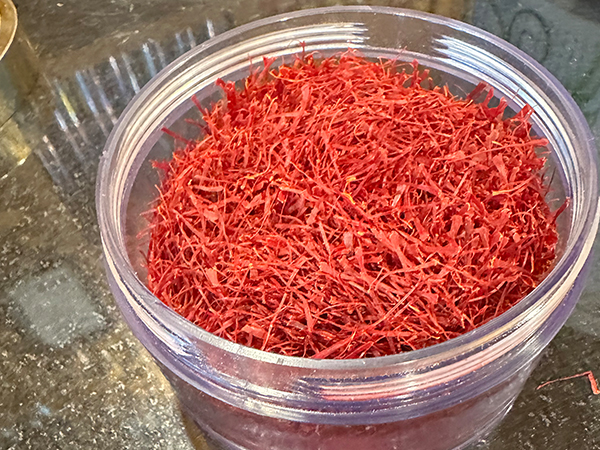Kashmir Saffron
Saffron is being cultivated in the Kashmir valley since 500 BC. Saffron cultivation in Kashmir is centered in the Pampore region, also known as the Saffron Bowl of India. Over 90 percent of the saffron grown in India comes from this region. The region’s natural highlands and loamy soil are ideal for saffron growth. The saffron grown in this area is the only saffron in the world grown at an altitude of 1800 metres above sea level. This itself adds to uniqueness and differentiates it from other saffron varieties available around the world.

Kashmir saffron, has many unique characteristics such as
Color: Kashmir saffron has a natural deep red color.
Stigmas: Kashmir saffron has longer and thicker stigmas than other saffrons.
Aroma: Kashmir saffron has a high aroma.
Flavor: Kashmir saffron has a bitter flavor.
Chemical processing: Kashmir saffron is processed without chemicals. Crocin, safranal, and picrocrocin: Kashmir saffron has high quantities of crocin (coloring strength), safranal (flavor), and picrocrocin (bitterness).
Texture: Kashmir saffron has a silky texture.
Kashmir saffron is acknowledged globally as a spice that rejuvenates health and is used for medical purposes and preparation of cosmetics. It is also used in preparation of various cusines to add colour, flavour and aroma to the cuisines.
The spice, known as Kesar in Hindi, Zaffran in Urdu and Kong in Kashmiri is extracted from the stigmas of the Crocus sativus flower, also known as the saffron crocus. The stigmas are the bright red-orange threads of the flower, and each flower only has three. The stigmas are collected and dried to be used as a spice and coloring agent.
The flowers are separated into three parts before drying: the red threads (stigma), yellow center (stamen), and purple petals. The stigmas are handpicked from each flower, spread on trays, and are either sun dried or vacuum dried. A single gram of saffron can be obtained from around 180- 200 flowers. This is a very labour-intensive work as the sitgma needs to be hand- picked and separated manually.
GI Tagging:
Major producers of saffron in the world are Iran, India, Spain and Italy. However, with the GI tag, India becomes the only saffron producing country for which GI tag has been assigned . This GI certification helps to cease the prevalent adulteration of saffron and put an end to the marketing of saffron cultivated in other countries under the garb of being produced in Kashmir.
What is GI certification:
A geographical indication (GI) is a sign used on products that have a specific geographical origin and possess qualities and reputation that are due to that origin. In order to function as a GI, a sign must identify a product as originating in a given place. In addition, the qualities, characteristics or reputation of the product should be essentially due to the place of origin. Since the qualities depend on the geographical place of the production, there is a clear link between the product and its original place of production.
Why Choose Our Products
Top-Quality Healthy Foods
Happy Customers
Our Benefits
We, at Venturo Overseas, take utmost care in harvesting and processing the crop to preserve and ensure the excellent quality of our Kashmir saffron:
- Harvesting: Harvesting of the saffron is done by experienced and trained hands and is not for the faint of heart. It takes 300,000 flowers with 600,000 stigmas to get 1 kg of saffron! Flowers are plucked early in the morning when they are just blooming, collected and taken for stigma separation. The stigma, stamens and petals are then separated. All this by hand and within 10-12 hours of plucking the flowers!!
- Drying: The separated stigma are then placed on trays in a single layer and dried in solar dryers to preserve the distinct flavour, aroma and texture of the saffron by bringing the moisture content to below 12 percent.
- Packaging: After drying, the saffron is immediately packed in airtight containers.
- Quality Assurance: Strict quality control and quality assurance measures are followed at every stage to ensure that only the best saffron reaches our clients.
- GI certification: Our saffron is GI certified. This ensures complete transparency about the place of origin, cultivation and processing techniques.
- At Venturo Overseas, we lay utmost stress on following Good Manufacturing Practices and Quality Control; and our zero tolerance policy ensures that every strand of saffron that reaches our clients the world over is of the most premium grade. No child labour is employed throughout the entire process.

